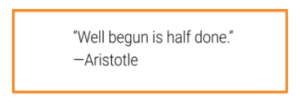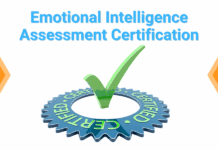
Setting high-quality goals can give you a big edge as a leader. A quality goal can inspire your team, set a clear path forward for each person, show people how their individual work impacts the bigger picture, and invoke a sense of pride at their accomplishment.
The key is knowing how to plan and map out your goal. One study showed that people who plan their goals carefully are 42% more likely to achieve them.
 The SMART approach to goal-setting gives you a thoughtful framework to employ each time you set a goal. The process increases the quality of your goals so you’re more likely to achieve them and grow from them along the way.
The SMART approach to goal-setting gives you a thoughtful framework to employ each time you set a goal. The process increases the quality of your goals so you’re more likely to achieve them and grow from them along the way.
What is a SMART goal?
SMART stands for Specific, Measurable, Attainable, Relevant, and Time-Bound. The acronym was coined in a 1981 article about the importance of goals in management. The authors write about how a manager’s ability to set goals is essential to their job. Goals drive a manager’s ability to lead their team and their ability to report results and objectives to senior leadership. To help managers set better goals, the paper proposed the SMART acronym, a simple framework that anyone—not exclusively managers—can follow to set smarter goals.
The 5-Letter, 5-Step Process to Set SMART Goals
Aristotle said that “Well begun is half done,” and you can think of SMART goals as that quality start. SMART goals push you forward further and faster by laying out a clear groundwork for what you want to accomplish. Here are the 5 components of a SMART goal:

Specific. A vague goal like “I want to get in shape,” sets yourself up for confusion and disappointment because you won’t know what success looks like. You also won’t know how you want to get there. Often, you will find that specificity splits your vague goal into a number of smaller goals. Ask yourself questions like: What am I trying to achieve and why? Who will be involved? What exactly will this plan look like in action?
Professional example: “I want to do well at work” may become “I want to be the top salesperson on the leaderboard.”
Personal example: “I want to get in shape,” may quickly become “I want to reduce my intake of sugar and red meat,” AND “I want to improve how fast I can run a mile.”
Measurable. Setting a measurable goal will help you make it more specific and trackable. As you work toward your goal, you will have data that suggests whether or not you’re moving in the right direction. Ask yourself questions like: How will I measure my progress and my success? What amount will make this a success?
Personal example: “I’m going to run a mile as fast as I can, set an improved target speed two months out, and then train to achieve it. My goal is to reduce my time from seven minutes to six minutes and forty seconds.”
Professional example: “I want to be the top salesperson on the leaderboard” might become, “I want to sell over $1million+ of our software. Last year I sold $800k and our winner sold $900k.”
Attainable. Don’t set yourself up for failure by overcommitting to goals you or your team could never accomplish. Critics of SMART goals often point to the attainable factor as an issue. They say it kills creativity and the ability to dream. In reality, attainable is about this specific goal, and it shouldn’t hold you back from dreaming big. In fact, setting attainable goals is an excellent way to chip away at bigger dreams without feeling overwhelmed or unsure where to begin. Attainability helps you avoid setting a goal so unrealistic that you give up or lose motivation. Not to mention, attainable goals can still push you to your limits. If you want to, you can set a goal that’s only attainable if you work sixteen hours a day. That’s still attainable, but it takes into account a realistic grasp of the effort required. Ask yourself questions like: Do you have the time and resources you need to accomplish this goal? If not, how might you adjust your goal to what you have or get the resources you need?
Personal example: Reducing your mile time by two minutes in two months is unrealistic for most, but twenty seconds may be much more realistic.
Professional example: “$1 million in sales is achievable because I wasn’t far off of $900k last year. I’ve built some new relationships, strengthened old ones, and if I work hard I could make this happen.”
Additional Sources:
Relevant. Considering relevance gives you an opportunity to think about how your goal fits into the bigger picture. With a personal goal, you might consider how your goal fits into your dreams and ambitions. With a team or leadership goal, relevance might also factor in how this goal impacts your organization. Relevance also helps you avoid setting SMART goals for smaller, more trivial tasks. It keeps you focused on goals that are high impact. Ask yourself questions like: What greater purpose does this goal serve? How will it impact my passions, values, beliefs, and ambitions? How might it impact my organization, community, or people close to me?
Personal example: “I have a family history of heart disease and I want a measurable, achievable goal by which you can track cardio strengthening.”
Professional example: “My long-term goal is to become our Chief Sales Officer, and striving to perform the highest of anyone in sales will be a big step in the right direction.”
Additional Source:
Time-bound. Time-bound goals ensure that you have a timeline to attach to your goal. Your timeline will help you determine and fine-tune many of the above factors. Ask yourself questions like: When can I accomplish this by? What will my timeline look like for myself and my team?
Personal example: “I want to train for two months. Looking at research online, shaving off 20 seconds on my mile time as an amateur just getting into running should be doable.”
Professional example: “I want to reach $1 million+ by the end of our fiscal year.”
5 Benefits of SMART Goals
Alignment. SMART goals align teams. When groups feel out of sync or demotivated, it’s often because they aren’t on the same page, aren’t committed to accomplishing the same thing, or don’t see their part in the process. A clearly laid out goal helps everyone see what they’re working toward and why, as well as how they’ll get there.
Motivation. The specificity of a SMART goal makes it more realistic and clear. Edwin A. Locke wrote about how quality goals are motivating. Specifically, he found that quality goals: 1) Turn something overwhelming into something immediately actionable, 2) Help focus your attention, and 3) Turn dreams into actionable plans.
Additional Sources:
Growth. Tracking progress helps you grow further faster. You can see more easily where you fell short and why. This turns failure into a measurable and clear insight, which helps you improve and accomplish your goal more quickly.
Time management. Without a careful look at a goal—what it entails and how it fits into the bigger picture—it’s tough to know how much time to allot. The SMART approach helps you get more specific and set a more accurate goal. This helps you manage your time with other tasks, decrease stress, and avoid burning out.
Additional Source:
Adaptability. A common critique of SMART goals is that they’re overly logical and get people stuck on plans that don’t work. In reality, the timebound and planful nature of a SMART goal should help you be more adaptable. Monitoring progress makes it easier to know when you’re clinging to a sinking ship, overestimating your time, resources, or abilities, or not actually as aligned with the bigger picture as you initially envisioned. Catching these issues early helps you see what’s going on more clearly which helps you adapt more effectively and quickly.
SMART Goal Example
Sales Team Leader: The leader of a sales team makes her initial goal to “use my sales team’s time more efficiently.” Then, she runs her goal through the SMART framework to refine it.
- Specific: I don’t want my salespeople spending any time with unqualified leads, and I don’t want my Sales Development Representatives screening people who are already qualified and should speak directly to a salesperson.
- Measurable: Specifically, I want 70% of my sales team's demos to convert to a second meeting (a 20% improvement), and to rarely or never hear that a salesperson had a wasted conversation.
- Attainable: This is attainable because we’ve counted qualified and unqualified leads and can devise a clear process that will help us better screen and qualify leads.
- Relevant: This is relevant because our organization has lofty objectives for sales growth and my team has mentioned often that they spend too much time with leads who have no intent to buy. This will free them up time to do the work that matters most.
- Time-Bound: We need to get the process in place within the next 30 days, and we need to see that 70% number within 60 days (It will take time to iron out the process).
A Fulfilling Life
There’s a lot of research that points to pursuing your passions as a powerful way to live a happier, more fulfilled life. SMART goals help you pursue your passions with more intention and motivation.
Additional Source:






